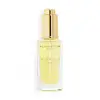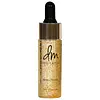What's inside
What's inside
 Key Ingredients
Key Ingredients

 Benefits
Benefits

 Concerns
Concerns

 Ingredients Side-by-side
Ingredients Side-by-side

Prunus Armeniaca Kernel Oil
MaskingPersea Gratissima Oil
Skin ConditioningOlea Europaea Fruit Oil
MaskingHelianthus Annuus Seed Oil
EmollientCaprylic/Capric Triglyceride
MaskingOrbignya Oleifera Seed Oil
EmollientSilica Dimethyl Silylate
EmollientCocoyl Hydrolyzed Collagen
CleansingRubus Idaeus Seed Oil
EmollientVaccinium Myrtillus Seed Oil
Skin ConditioningOenothera Biennis Oil
EmollientLavandula Angustifolia Flower Oil
MaskingJasminum Officinale Flower Extract
MaskingTocopheryl Acetate
AntioxidantCitrus Aurantium Amara Flower Oil
MaskingAcmella Oleracea Extract
Skin ProtectingRosa Centifolia Flower Extract
AstringentTocopherol
AntioxidantCombretum Farinosum Flower Nectar
MaskingAlcohol Denat.
AntimicrobialLimonene
PerfumingCitronellol
PerfumingGeraniol
PerfumingLinalool
PerfumingPrunus Armeniaca Kernel Oil, Persea Gratissima Oil, Olea Europaea Fruit Oil, Helianthus Annuus Seed Oil, Caprylic/Capric Triglyceride, Orbignya Oleifera Seed Oil, Silica Dimethyl Silylate, Cocoyl Hydrolyzed Collagen, Rubus Idaeus Seed Oil, Vaccinium Myrtillus Seed Oil, Oenothera Biennis Oil, Lavandula Angustifolia Flower Oil, Jasminum Officinale Flower Extract, Tocopheryl Acetate, Citrus Aurantium Amara Flower Oil, Acmella Oleracea Extract, Rosa Centifolia Flower Extract, Tocopherol, Combretum Farinosum Flower Nectar, Alcohol Denat., Limonene, Citronellol, Geraniol, Linalool
Ingredients Explained
These ingredients are found in both products.
Ingredients higher up in an ingredient list are typically present in a larger amount.
This ingredient is an emollient, solvent, and texture enhancer. It is considered a skin-softener by helping the skin prevent moisture loss.
It helps thicken a product's formula and makes it easier to spread by dissolving clumping compounds.
Caprylic Triglyceride is made by combining glycerin with coconut oil, forming a clear liquid.
While there is an assumption Caprylic Triglyceride can clog pores due to it being derived from coconut oil, there is no research supporting this.
Learn more about Caprylic/Capric TriglycerideHelianthus Annuus Seed Oil is the oil derived from the seeds of a Sunflower. Sunflower seed oil is non-fragrant. It is an emollient, meaning it helps to soften the skin.
Sunflower seed oil contains many fatty acids. The fatty acids found in sunflower seeds include (from highest amount to least): linoleic acid, myristic acid, palmitic acid, stearic acid, arachidic acid, oleic acid, and linolenic acid.
These fatty acids help the skin create ceramides. Ceramides play a role in repairing the skin barrier.
Helianthus Annuus Seed Oil helps moisturize the skin. This in turn helps the skin look more rejuvenated and smoother.
Sunflowers are rich in vitamin E.
Historians believe Indigenous cultures of North America domesticated sunflowers before corn. Thus they relied on sunflower oil for a variety of uses. One such use is moisturizing skin and hair.
Sunflower seed oil may not be fungal acne safe. We recommend speaking with a professional if you have any concerns.
Learn more about Helianthus Annuus Seed OilOlea Europaea Fruit Oil is the fixed oil obtained from the ripe fruit of the Olive. In other words - olive oil.
The primary contents of olive oil are glycerides of the fatty acids linoleic, oleic and palmitic.
Olive oil also contains antioxidants such as Vitamin E. Antioxidants may help reduce signs of aging by fighting unstable free-radical molecules. It also contains Vitamins A (retinol), D, and K.
The squalene in olive oil makes it a great emollient. Emollients help soothe and soften your skin by trapping moisture in. This makes olive oil a great skin moisturizer.
Studies show olive oil to have antibacterial and antifungal properties in low concentrations. Another study found olive oil irritated sensitive oily skin. We always recommend speaking with a professional about using this ingredient in your routine.
Due to the fatty acid content, this ingredient may not be fungal-acne safe.
Learn more about Olea Europaea Fruit Oil